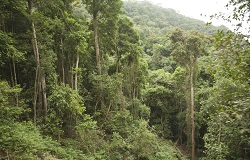Breaking the cycle of forest loss in the Amazon
The Amazon is at risk of what has been described as a ‘die-back circle’, where forest loss increases as a result of reduced rainfall and human activities such as logging. Crucially, that reduction itself leads to yet more drought conditions. Human induced climate change also threatens to further reduce rainfall, exacerbating the situation. Being able to predict which regions of the Amazon are susceptible to this loss is therefore critical to avoid worsening conditions. Towards this end, researchers have recently reported that the presence of a variety of tree species are a good indicator of the likelihood of survival for forest regions. Reporting in the journal ‘Nature Communications’, the lead-author Dr. Delphine Clara Zemp of the Potsdam Institute for Climate Impact Research, Germany, reminds us why this research matters by simply stating that, ‘The Amazon rainforest is one of the tipping elements in the Earth system.’ A self-sustaining but vulnerable system The Amazon is significantly self-sustaining with plants evaporating moisture, which subsequently returns as rain. Yet at the same time it remains vulnerable to environmental changes, such as that brought about by deforestation and as a result of greenhouse gas emissions, both inhibiting moisture transportation. With the added influence of sea-surface temperature rise, all the indications are for an increase in both extremes of wet and dry seasons, especially in Southern and Eastern Amazonia. The researchers point out in their article that while the die-back circle was relatively well known, the consequences of the atmosphere-vegetation feedback loop have been less well understood. Using a network analysis of water fluxes, they found that the more diverse the vegetation, the less vulnerable it seems to be to destruction. ‘Since every species has a different way of reacting to stress, having a great variety of them can be a means for ecosystem resilience,’ stated Prof. Marina Hirota from the Federal University of Santa Catarina, Brazil. Biodiversity for climate change mitigation These latest findings build on previous research from the team which evidenced why this feedback loop matters. The EU-funded ROBIN project (finalised in 2015) looked at the role of biodiversity in climate change mitigation in tropical Latin America. They employed remote sensing data to improve techniques for monitoring, reporting and verifying carbon stocks, as well as large-scale regional models. Researchers also analysed how different climate and socioeconomic scenarios and land-use options could influence carbon storage and biodiversity in the long-term. Local case studies were conducted at different sites across a climatic gradient of tropical forest areas. Biodiversity indicators were divided into four categories (taxonomic, functional, structural and landscape) and combined into a single ‘ecosystem integrity’ value. This was used to represent the overall health of the ecosystem. ROBIN found that biodiversity has a direct positive impact on climate change by absorbing carbon dioxide from the air, and so can play a key part in mitigation policies such as REDD+ (the Reducing Emissions from Deforestation and forest Degradation initiative), by providing carbon stores. Being able to identify areas under threat – and understanding the mechanism for this degradation - contributes significantly towards putting effective mitigation efforts into place. Indeed, AMAZALERT, another EU-funded project involving the same researchers, had already created an early warning alert system based on land-use policies and reports from the region. For further information please visit: ROBIN CORDIS project page AMAZALERT CORDIS project page
Countries
Netherlands, United Kingdom



